Get your research organised - and free up more time for finding ancestors - with Helen Tovey's three top organisation tools.
In a new series in Family Tree, over the coming months we will be looking at some of the many ways in which digital aids can transform our research processes. We’ll be looking at the must-have technology items for the family historian, and exploring some of the newer and just “nice to have ones” too.
To help get us started, Helen Tovey shares three top organisation tools, and invites you to share your own ideas too:
1. Tackle those to-do lists
To help you keep track of the myriad tasks required when researching your family history, it definitely pays to make notes and lists. Generic software you may already have to hand can be employed this way, for instance: Excel (Microsoft), Calc (OpenOffice – free), and GoogleSheets (GoogleDrive – free). Alternatively you might like to try a dedicated project management tool to help keep you organised and motivated, such as Trello.com. With free and premium levels available, Trello helps you manage your projects, creating to-do lists and done list.
2. Get mind mapping
Often at the start of something, perhaps a new branch of your family tree, or a new family history project you’d like to tackle, your ideas will be swimming around your head in no logical order. Committing them to the page is a good step to take, to help you work out what you wish to concentrate on and how you’re going to go about it.
If you’re a visual thinker, mind-mapping is ideal for this stage of a germinating project – as it doesn’t require you to create an orderly list. Instead, just note down the points, adding further ideas as they come to you. Gradually you will be able to bring some order to your inspiration and make a plan using the details on your mind-map. e.g. Try Lucid Chart (free trial, thereafter £8.99 a month).
3. Streamline your note-taking
If you’re looking for a digital notebook, OneNote (Mac and PC, Android & iOS) may be just for you – use it to create multiple notebooks, within which you can create sections and pages. Images can be dropped on to your page, as can multiple text boxes – just click and start typing wherever you wish. You can even draw with it – perhaps the perfect tool for sketching out a family tree, or doodling visual aid notes while listening to a talk.
Scrivener (£17.99 for the app, £47.99 for the desktop/laptop software) and Evernote are widely popular with genealogists, likewise for PC, Mac and via an app for devices). GoodNotes and Notability are other digital notebook options, particularly good for handwritten notes on an iPad.
We want to hear from you...
Over the next few issues we will look at specific areas of gadgets, apps etc for genealogy purposes.
We would also love to hear what you find useful and why. Please email Helen Tovey with the details and we look forward to sharing your advice in a future issue.
We will include mention of as many reader recommendations as possible and for those that we showcase we will pay £30.
Extracted from 'genealogy apps and gadgets' from the June 2022 issue of Family Tree magazine. Get your copy here.








